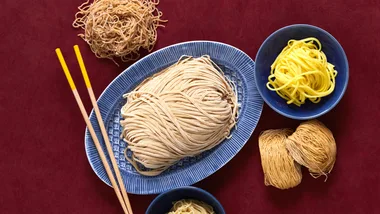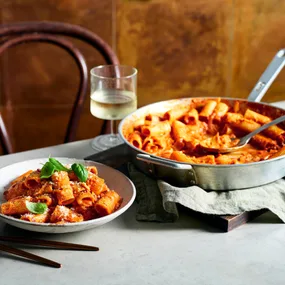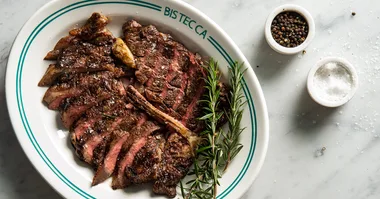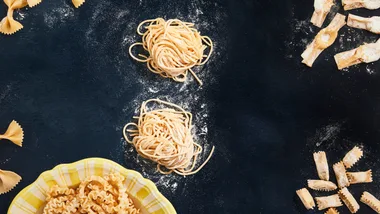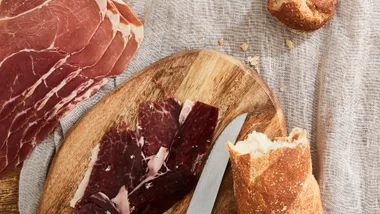When it comes to a celebration a layered cake is hard to beat, and this vanilla version frosted with buttercream is a great place to start. The cake itself is based on a recipe by American baker and author Rose Levy Beranbaum to which I’ve added brown sugar for more moisture. It’s a simple, fluffy cake that’s not meant to be served alone, but makes a great base for dressing up to something grander and can easily be adapted with different flavourings.
When I bake, I always prepare the cake tins and weigh all the ingredients (and preheat the oven) before I start. The cake tins need to be buttered all over, dusted with flour and lined on the base with baking paper. Have all the ingredients at room temperature so the batter comes together better.
It’s best to use cake flour for baking a cake; its lower protein content gives a softer result. If you don’t have any, you can mix a little cornflour with all-purpose flour to soften it. Baking powder is the raising agent here. It can lose its power if it’s not fresh, so test it by adding a teaspoonful to warm water – if it fizzes, it’s fine to use.
When it comes to sugar, caster sugar gives sweetness and a fine crumb – it dissolves easily – and, as I’ve said, brown sugar adds moisture. And always add a good pinch of salt to cake batter to deepen the flavour.

Tip 1: Mix the butter into the flour.
(Photo: Ben Dearnley)Tip 1: Mix the butter into the flour
For this cake, I mix the butter into the flour rather than creaming it with the sugar; the fat coats the flour protein, which produces a finer, fluffy texture. I also whisk the eggs with milk before I add them to the batter so they mix in more evenly. When it comes to transferring the batter to the prepared tins, if you want the layers to be perfectly even, weigh the batter into thirds first.

Tip 2: Don’t overbake (and don’t peek in the oven too early).
(Photo: Ben Dearnley)Tip 2: Don’t overbake (and don’t peek in the oven too early)
Be careful not to overbake these cakes or they’ll dry out, and don’t open the oven until they’ve baked for at least 20 minutes. Ideally, you’d bake the cakes in the centre of the oven, but if you can’t fit them all on one rack, use two racks, with one placed a third of the way up and another at two-thirds, and rotate the cakes after 20 minutes so they cook evenly. They should, of course, be cooled completely before you frost them, and each is halved to make six layers for a truly impressive layer cake. The cakes are best fresh, but they can be frozen.

Tip 3: To make your frosting, make sure you cool the meringue mixture.
(Photo: Ben Dearnley)Tip 3: To make your frosting, make sure you cool the meringue mixture
The frosting here is a Swiss meringue buttercream. For Swiss meringue, eggwhites and sugar are heated over a saucepan of simmering water to pasteurise and stabilise the eggwhites. The water should be only just simmering; ensure the bowl doesn’t touch the water or the egg will overcook. Lightly whisk the eggwhites to dissolve the sugar until the mixture reaches 53C. If you don’t have a thermometer, it should feel warm and you’ll see the sugar has dissolved and the mixture has become glossy. Transfer the mixture to an electric mixer and whisk until the meringue cools completely and firm, glossy peaks form. If you don’t cool the meringue, the butter will melt when you add it and you’ll need to start over.
With the mixer running, add the softened butter a little at a time so it gets incorporated evenly. After you’ve added about three-quarters of the butter, the mixture may split a little, but as you keep adding more it will come together again. If you live somewhere hot, replace 150gm butter with vegetable shortening, which will make the mixture more stable in the heat; it also makes it whiter, so try this if you prefer that look.
When all the butter is added, switch to the paddle attachment for a super-smooth buttercream. If you like you can add a little food colouring; I add a little titanium dioxide to whiten the buttercream.

Tip 4: Fill your piping bag sans air pockets.
(Photo: Ben Dearnley)Tip 4: Fill your piping bag sans air pockets
For a ruffled finish, I use a Wilton petal or flat-tip nozzle, which creates a ribbon effect. You can find these at cake-decorating shops. Snip the end of the piping bag, insert the nozzle, twist the bag above the nozzle to stop the mixture leaking out and push the buttercream towards the nozzle as you fill the bag to prevent air pockets. The buttercream stores well in the fridge or freezer, so you can make it ahead; just bring it to room temperature before using it and beat it briefly to make it smooth again.
Now the frosting and cake are ready to go, choose a jam to complement the cake. I’ve gone for rose jam here, and added a little rosewater to the frosting as well.

Tip 5: Use a lazy Susan to assemble your cake
(Photo: Ben Dearnley)Tip 5: Use a lazy Susan to assemble your cake
When assembling the cake, I like to use a lazy Susan to rotate it so it’s easier to spread the layers evenly. Spread some jam over one cake half, leaving a 5mm border, then top it with a generous half-cup of buttercream and spread that to the edges. Repeat these layers, finishing with the last cake round.

Tip 6: Pipe the frosting from the base of the cake.
(Photo: Ben Dearnley)Tip 6: Pipe the frosting from the base of the cake
Spread a little frosting all around the outside of the cake to seal the crumbs and create an adhesive surface, then start piping from the base and work upwards. Have the nozzle touching the side of the cake as a guide and pipe quickly, starting from right on the board, in a short width backwards and forwards, working upwards, to create a ribbon effect.

Vanilla-rose layer cake recipe
(Photo: Ben Dearnley)Vanilla-rose layer cake recipe
You’ll need a large (5-litre) mixing bowl on your electric mixer to make the buttercream; otherwise make it in two batches. I prefer the precision of weight measurements for all ingredients, which is usual practice for pastry chefs.
This cake is best served at room temperature and on the day it’s made. On a cool day it can stand at room temperature for up to four hours before serving, making it ideal for preparing in advance of an occasion.
Ingredients
Method
Main
Note Cake flour is available from select supermarkets; to make it, remove 2 tbsp from each cup of plain flour, and replace with 2 tbsp cornflour. Titanium dioxide is a whitening agent available from cake-decorating suppliers.
Notes


